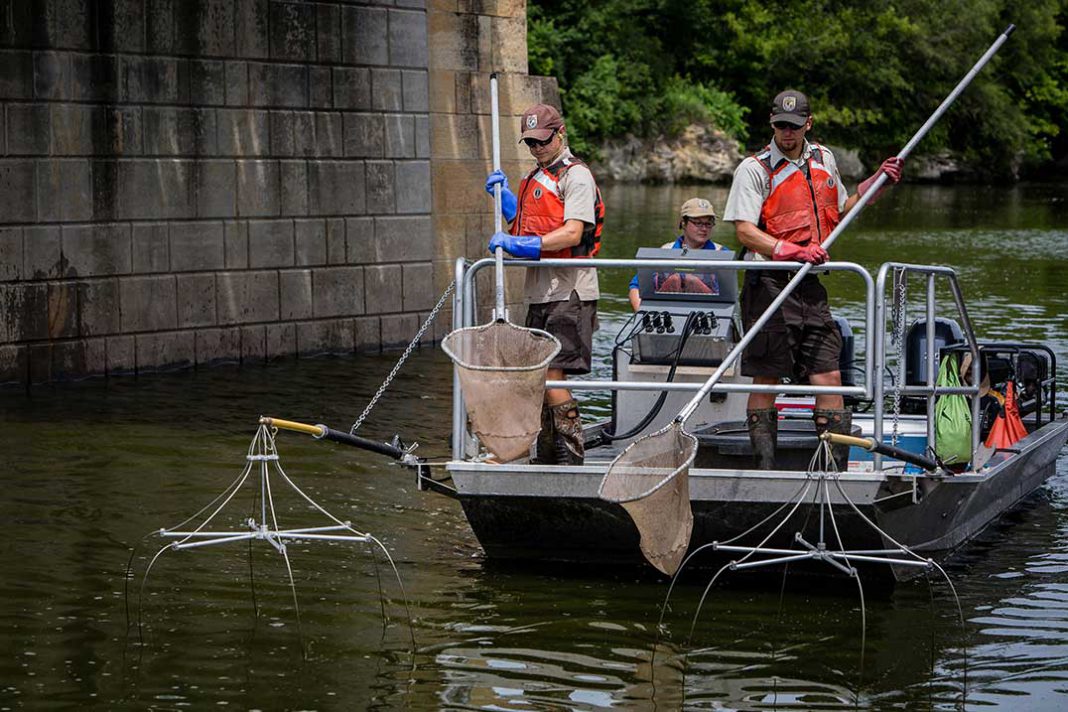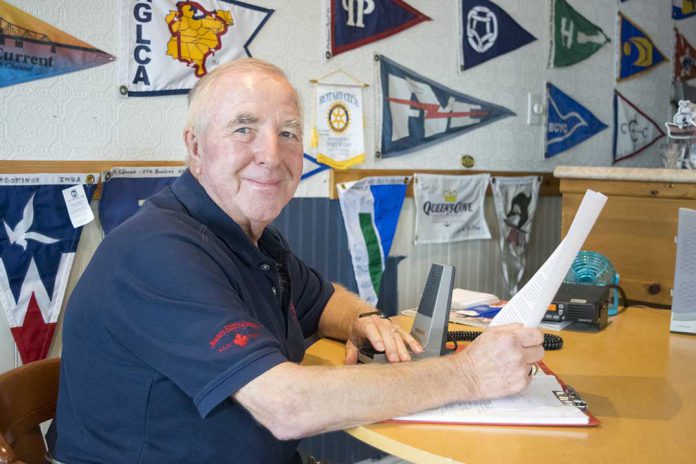Part III of a series on grass carp in the Great Lakes and the threat they pose to Lake Huron’s wetland ecosystems
GREAT LAKES—The threat of Asian carp seems to be a large, daunting challenge, but agencies on both sides of the border have agreed to work together to break up the heavy workload. Although many are approaching the invasive grass carp issue in their own ways, they still collaborate to be more effective in their management and eradication attempts, wherever possible.
International commitments
Several agencies have agreed to collaborate on managing these invasive species. The Lake Erie Committee is a part of the Great Lakes Fishery Commission, the latter of which ensures cross-border collaboration to foster healthy native fish populations. Environmental groups from the Pennsylvania, New York, Ohio, Michigan and Ontario governments (such as the Ontario Ministry of Natural Resources and Forestry (MNRF)) have representatives on the Lake Erie Committee.
For Lake Huron, the Ontario MNRF and Michigan Department of Natural Resources (DNR) collaborate on fishery management along with the Chippewa-Ottawa Resource Authority. On a higher level, Fisheries and Oceans Canada (DFO), the U.S. Fish and Wildlife Service (USFWS) and U.S. Geological Survey (USGS) are partners in Asian carp management across the Great Lakes—grass carp are one of four subspecies of invasive Asian carp.
At the state and provincial level, regions that border the Great Lakes have signed what is called a mutual aid agreement. If an emergency response effort is required in any jurisdiction, the signatories have all agreed to send crews to help the home agency. Although no grass carp emergency measures have been called for since the agreement was signed in 2014 (Illinois signed in 2015), there have been a few binational gatherings to conduct eradication efforts in the spirit of the agreement.
Commercial cooperation
Seth Herbst, aquatic invasive species coordinator for the Michigan DNR, says there is another major partner in capturing these fish in the waters of the Great Lakes: commercial fisheries. Mr. Herbst says commercial fishing operations capture a much higher amount of fish compared to his agency, simply because they are on the water every day.
“Since 2013, roughly 116 grass carp have been removed by commercial fishers,” says Mr. Herbst, a number that he calls “quite a bit more than our agency.”
When commercial fishers catch grass carp in their gear, they often send those fish to an agency such as the Michigan DNR to conduct tests. The agency will be able to determine whether the fish is diploid (fertile) or triploid (sterile) through its ploidy testing. Statistics on commercial catches are kept and added to a growing body of knowledge about Asian carp.
As a way of incentivizing commercial fishers to continue capturing and sending in Asian carp, the Michigan DNR has introduced a bounty program—commercial fishers receive $75 for every Asian carp they send into the DNR. Mr. Herbst also says his agency informs fishers of places where Asian carp are known to congregate in the hopes that they will be able to fish in the area and remove more individuals from the system.
Broader collaborations
Commercial fishers are only one group that Michigan partners with—Mr. Herbst says his agency is starting to partner with recreational bowfishers in the hunt for grass carp. These recreational anglers mainly hunt at night, armed with a bow and arrows that have a rope attached to them. Since carp tend to congregate in shallow water, they are a favourite target for bowfishers.
That has created business opportunities, too. Numerous companies operate around the Great Lakes states and beyond that offer bowfishing charters. Gene Hobbes owns Bowfishing Madness, a Georgia-based charter company. He says in his area, grass carp populations tend to fluctuate on a year-to-year basis which makes them difficult to target.
While bowfishing seems like a novel way of managing invasive species—numerous tournaments have started, especially in Illinois where Asian carp are prevalent—Mr. Hobbes is less optimistic about the impact of bowfishers.
“It definitely helps but when you run into things like the Asian carp that are reproducing so fast, I don’t even think bowfishers can put a dent in those,” he says.
Nick Anthony, who owns Rooster Ranch, south of Bad Axe, Michigan, says bowfishers should be receptive to a partnership.
“A lot of the sportsmen are looking for something to do in that spring timeframe. A lot of the other seasons are closed; it’s something to get out there and enjoy the outdoors,” says Mr. Anthony.
Conversely, western Michigan’s Bulls Eye Bowfishing and Archery owner Scott Hodges says that, although he has not heard of any incentives to catch grass carp, he would probably only participate in those programs if they were local or could offer a significant reward for helping out.
A unified effort
Keeping so many stakeholders organized and working together is no small task. To help decide on the best course of action for grass carp, a number of the agencies have implemented a structured decision-making (SDM) process sponsored by Michigan State University (MSU). Michael Jones is the head of the SDM process at MSU; he has worked with a number of agencies around the basin in the past and had been approached to take on the grass carp issue as well.
He works closely with Kelly Robinson, an assistant professor in the department of fisheries and wildlife at MSU, who helps to facilitate SDM. She says the process helps to define the core problem at hand, a key first step.
“One of the biggest issues in resource management, from the start, is when there’s confusion about the problem you’re working on,” says Ms. Robinson. “The fact that we have everyone coming together to discuss how actions played out this fall is a benefit to everyone in the system.”
Although SDM provides a great deal of clarity, some say it has major flaws in the speed at which it operates. Nick Mandrak, a researcher at University of Toronto, says the process is overly linear. He says participants will attempt one technique, wait to see how it fares, and then start planning for their next steps.
“Eradication responses should happen immediately. While that’s happening, plans should be developed for longer-term management for species if the eradication fails,” says Mr. Mandrak. “We should not wait to hear an effort has failed to determine the tools we need.”
Ms. Robinson disagrees with the linear description, and instead refers to the process as cyclical.
“You can loop back if things come up that you hadn’t thought of,” she says. “It does take some time to work through the process which I think is good in some ways because it’s causing people to think more fully about ways of thinking through the process.”
Becky Cudmore, Asian carp program manager at Fisheries and Oceans Canada (DFO) agrees that swift action is crucial; however, she concedes that managing the Great Lakes poses unique challenges.
“It’s an interesting study in multiple jurisdictions co-managing a body of water,” she says. “When the actions or inactions of one jurisdiction does influence the others, it obviously leads to the need for open communication and discussion. We definitely encourage that to continue in the future.”
SDM does not appear to be addressing all issues equally, though. This summer, officials have demolished a dam on the Sandusky River in Ohio—a known grass carp breeding ground. To date, there are no finalized measures in place to stop Asian carp from moving upstream to breed.
Ballville Dam
The Ballville Dam was a 1913-built hydroelectric and water-supply dam for the city of Fremont, Ohio. The structure was in a state of “high disrepair” and beginning to pose a safety risk to residents, as well as acting as a barrier to native fish species like walleye that prevented them from spawning further upstream. The cost to remove it was much lower than repairing the structure, located 18 miles upstream of Lake Erie.
Rich Carter executive administrator for fish management and research with the Ohio DNR says the need to remove the dam has been discussed for 20 years, though its fate remained unclear until recently.
“There have been a number of delays in the removal of the dam so that the actual removal of the dam was not certain until about 18 months ago,” he says.
The USFWS had completed its final environmental impact statement on the Ballville Dam removal on Aug. 1, 2014. The document is 689 pages long, with 407 of those being appendices. Appendix E, at the end of the document, is an invasive species risk assessment. It is seven pages in length.
The appendix notes the positions of a team of 11 researchers who have added their expertise on the project. Of the 10 who submitted enough information to be useful to the study, seven believe grass carp have not established self-sustaining populations in the Lake Erie basin. Their confidence in their own responses was mostly low, but six of the researchers had given their opinions on the impact of dam removal on Asian carp. Four researchers predicted no change, while the other two suggested an increase in risk.
At the end of the study, those results were interpreted to mean no increased risk potential to the presence of Asian carp in the Lake Erie basin.
Officials have known about the dam’s impending demise for two decades and had finalized plans to remove it 18 months ago. Despite this knowledge, when the dam came down this summer, there were no measures in place to block invasive species like grass carp from moving upstream to spawn.
“We are basing our decisions for grass carp actions on the results of the structured decision-making and ongoing science and probability of success. Recommendations for barriers came about through the structured decision-making process,” says Mr. Carter.
Ms. Robinson says weirs and other barriers to fish passage have been considered since early in the SDM process, but the dam removal had been “already slated to happen before our process started.”
The SDM’s final recommendations came out six months ago, relatively close to the dam’s removal date. Mr. Carter says something will need to be done on the Sandusky River, however what it will entail or when it will be installed remains unknown.
“We recognize that that does increase available habitat for spawning. Part of our future plans are to conduct a barrier feasibility study or design to determine how and where hydrological barriers might be used to block movements of grass carp and support population reductions in the Sandusky and Maumee Rivers,” he says.
Another aspect in favour of the dam’s removal had been promoting native fish populations. Any barrier to fish movement in the river would also continue to disrupt their natural patterns, an issue that must also be considered in determining the next steps for Asian carp management in the Sandusky River.





